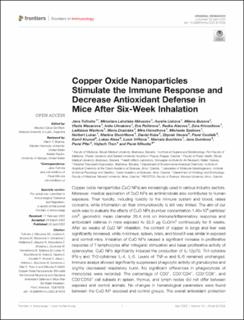| dc.contributor.author | Tulinska, Jana | |
| dc.contributor.author | Mikusova, Miroslava Lehotska | |
| dc.contributor.author | Liskova, Aurelia | |
| dc.contributor.author | Busova, Milena | |
| dc.contributor.author | Masanova, Vlasta | |
| dc.contributor.author | Uhnakova, Iveta | |
| dc.contributor.author | Rollerova, Eva | |
| dc.contributor.author | Alacova, Radka | |
| dc.contributor.author | Krivosikova, Zora | |
| dc.contributor.author | Wsolova, Ladislava | |
| dc.contributor.author | Dusinska, Maria | |
| dc.contributor.author | Horváthová, Mira | |
| dc.contributor.author | Szabova, Michaela | |
| dc.contributor.author | Lukan, Norbert | |
| dc.contributor.author | Stuchlikova, Martina | |
| dc.contributor.author | Kuba, Daniel | |
| dc.contributor.author | Vecera, Zbynek | |
| dc.contributor.author | Coufalik, Pavel | |
| dc.contributor.author | Krumal, Kamil | |
| dc.contributor.author | Alexa, Lukas | |
| dc.contributor.author | Vrlikova, Lucie | |
| dc.contributor.author | Buchtova, Marcela | |
| dc.contributor.author | Dumkova, Jana | |
| dc.contributor.author | Piler, Pavel | |
| dc.contributor.author | Thon, Vojtech | |
| dc.contributor.author | Mikuska, Pavel | |
| dc.date.accessioned | 2022-06-14T07:30:31Z | |
| dc.date.available | 2022-06-14T07:30:31Z | |
| dc.date.created | 2022-06-13T10:05:38Z | |
| dc.date.issued | 2022 | |
| dc.identifier.citation | Frontiers in Immunology. | en_US |
| dc.identifier.issn | 1664-3224 | |
| dc.identifier.uri | https://hdl.handle.net/11250/2998614 | |
| dc.description.abstract | Copper oxide nanoparticles (CuO NPs) are increasingly used in various industry sectors. Moreover, medical application of CuO NPs as antimicrobials also contributes to human exposure. Their toxicity, including toxicity to the immune system and blood, raises concerns, while information on their immunotoxicity is still very limited. The aim of our work was to evaluate the effects of CuO NPs (number concentration 1.40×106 particles/cm3, geometric mean diameter 20.4 nm) on immune/inflammatory response and antioxidant defense in mice exposed to 32.5 µg CuO/m3 continuously for 6 weeks. After six weeks of CuO NP inhalation, the content of copper in lungs and liver was significantly increased, while in kidneys, spleen, brain, and blood it was similar in exposed and control mice. Inhalation of CuO NPs caused a significant increase in proliferative response of T-lymphocytes after mitogenic stimulation and basal proliferative activity of splenocytes. CuO NPs significantly induced the production of IL-12p70, Th1-cytokine IFN-γ and Th2-cytokines IL-4, IL-5. Levels of TNF-α and IL-6 remained unchanged. Immune assays showed significantly suppressed phagocytic activity of granulocytes and slightly decreased respiratory burst. No significant differences in phagocytosis of monocytes were recorded. The percentage of CD3+, CD3+CD4+, CD3+CD8+, and CD3-CD19+ cell subsets in spleen, thymus, and lymph nodes did not differ between exposed and control animals. No changes in hematological parameters were found between the CuO NP exposed and control groups. The overall antioxidant protection status of the organism was expressed by evaluation of GSH and GSSG concentrations in blood samples. The experimental group exposed to CuO NPs showed a significant decrease in GSH concentration in comparison to the control group. In summary, our results indicate that sub-chronic inhalation of CuO NPs can cause undesired modulation of the immune response. Stimulation of adaptive immunity was indicated by activation of proliferation and secretion functions of lymphocytes. CuO NPs elicited pro-activation state of Th1 and Th2 lymphocytes in exposed mice. Innate immunity was affected by impaired phagocytic activity of granulocytes. Reduced glutathione was significantly decreased in mice exposed to CuO NPs. | en_US |
| dc.language.iso | eng | en_US |
| dc.rights | Navngivelse 4.0 Internasjonal | * |
| dc.rights.uri | http://creativecommons.org/licenses/by/4.0/deed.no | * |
| dc.title | Copper Oxide Nanoparticles Stimulate the Immune Response and Decrease Antioxidant Defense in Mice After Six-Week Inhalation | en_US |
| dc.title.alternative | Copper Oxide Nanoparticles Stimulate the Immune Response and Decrease Antioxidant Defense in Mice After Six-Week Inhalation | en_US |
| dc.type | Peer reviewed | en_US |
| dc.type | Journal article | en_US |
| dc.description.version | publishedVersion | en_US |
| dc.rights.holder | © 2022 Tulinska, Mikusova, Liskova, Busova, Masanova, Uhnakova, Rollerova, Alacova, Krivosikova, Wsolova, Dusinska, Horvathova, Szabova, Lukan, Stuchlikova, Kuba, Vecera, Coufalik, Krumal, Alexa, Vrlikova, Buchtova, Dumkova, Piler, Thon and Mikuska. | en_US |
| dc.source.volume | 13 | en_US |
| dc.source.journal | Frontiers in Immunology | en_US |
| dc.identifier.doi | 10.3389/fimmu.2022.874253 | |
| dc.identifier.cristin | 2031282 | |
| dc.source.articlenumber | 874253 | en_US |
| cristin.ispublished | true | |
| cristin.fulltext | original | |
| cristin.qualitycode | 1 | |

